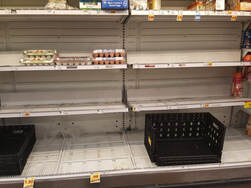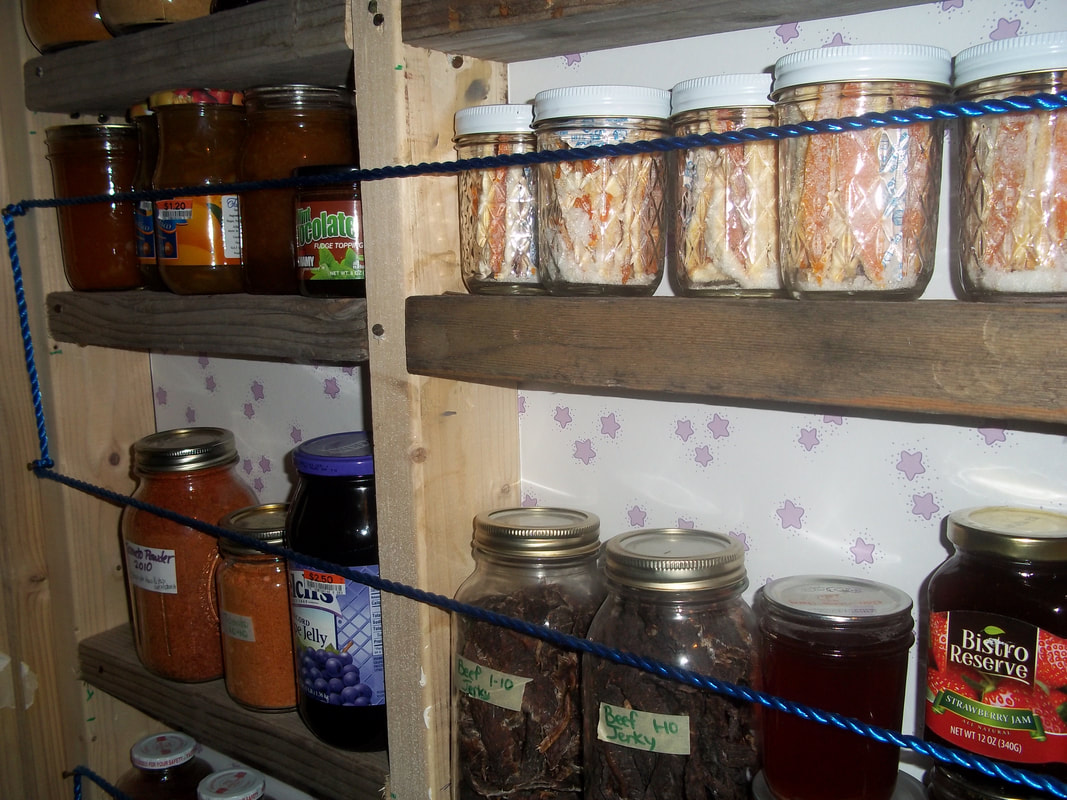The overview of how to do it is found on the page 52 Weeks of Building Storage.
Why prepare?
To be more secure, self-reliant
We were able to be calm and logical because my family is OK. I’ve stored food since I left for college as an older teen. Back then it was limited to a cardboard bushel box in my closet, filled with cans and packages. But it was something.
A friend and I were talking yesterday about storing food, and she asked, “Isn’t it a little too late now?”
That depends.
It’s too late to do anything in advance of this part of this crisis, but there’s time to be smart in the middle of it. And there’s time to prepare for whatever else may happen in our personal lives. I think these recent events have put us on the level of much of the rest of the world, seeing limited resources at the stores. My church has emphasized food storage and financial preparation for decades. They even teach this to people in Argentina who can’t afford to buy an extra pound of sugar—but they can save a tablespoon at a time. You can always do something, whether it’s growing, gleaning, creating, purchasing, or wasting less.
When I was 10, my family moved to a farm and ranch in a tiny valley in eastern Utah. We were very low-income- less than we'd make simply going on welfare. But my mom was powerful. Smart. Hard working. Determined and good at creating and conserving.
A scripture has stuck in my head the last couple weeks; “She is not afraid of the snow for her household.”
Here is part of the chapter that is from:
“Who can find a virtuous [Chayil: ‘a force’; strong or powerful] woman? for her price is far above rubies….She is not afraid of the snow for her household: for all her household are clothed with scarlet. [this suggests warmth and comfort, and faith in Jesus]…Strength and honour are her clothing; and she shall rejoice in time to come. [this is better translated as ‘smiles at the coming day’, not fearing it.] She looketh well to the ways of her household, and eateth not the bread of idleness [what she has not worked to earn]. Her children arise up, and call her blessed; her husband also, and he praiseth her. Many daughters have done virtuously [been powerful or strong], but thou excellest them all. Favour is deceitful, and beauty is vain: but a woman that feareth the LORD, she shall be praised. Give her of the fruit of her hands [what she has made and created]; and let her own works praise her in the gates.” (Proverbs 31, verses 10,21,25,27-31)
We have this kind of power, this opportunity, in our homes! That’s what being a wife and mother is about. Confidence and true power comes from learning and living correct principles. God will help you on this journey to building a family storehouse.

That farm we lived on was two hours from stores. We shopped once a month, for our family of 9. We drank 6 gallons of milk a week, and there was no way to fit 24 gallons of milk in the fridge after shopping. So Mom bought 6 gallons each month. She always kept a storeroom full of basic foods, including powdered milk. As we needed milk, each jug was mixed with 3 gallons of powdered milk, to make 4 gallons. That way the 6 gallons became 2 dozen.
We raised beef cattle, so we had our own beef. A neighbor across the river raised hogs, and we’d trade him beef for pork. We had a huge garden- we grew almost all of our vegetables, and Mom was insistent on that 5 or more servings a day of fruits and vegetables. The only vegetables I remember buying were frozen peas and tomato sauce. Elderberries, chokecherries, and currants grew wild on the farm, so we picked and made jelly from them. We grew strawberries and had a huge raspberry patch. We stored our garden carrots through the winter in an insulated pit in the garden. We canned and bottled a lot, froze corn, zucchini, asparagus, spinach. If we didn’t have something for a recipe we wanted, we came up with a substitute, or went without.
It was a different mindset, a different way of living. What we’re seeing now reminds us of how fragile our modern way of life is, and helps us better appreciate traditional ways, including making and filling a family storehouse. Now I live in a valley with one million other people, and I can’t do all the things we did on the farm. But I can grow food and preserve it, store and waste less.
What about Hoarding?
People who store are sometimes accused of hoarding. And sometimes they ARE hoarding. So what is the difference between preparing and hoarding?
‘Hoarding’ involves selfishness or coveting on one or both sides of the equation. On one side, it could merely mean somebody is upset at what you have-- coveting-- and on the other side, you might be acting like a dragon clutching its pile of gold and belching fire at anyone who comes near. There’s God’s way of preparing for the future, and there are a whole bunch of other ways. God’s way includes loving your neighbor as yourself. Use that as your guideline for building and using food storage. Don’t build in a way that takes from others who need it. Building a godly family storehouse is “is founded on the doctrines of love, service, work, self-reliance, and stewardship”.
What is the ideal to work towards in building a family storehouse?
A two-week basic water supply, a financial reserve, a three-month supply of everyday food and recipes to use it, a good supply of basic foods that store a very long time, and the skills to use them. That will give you stability and security, and helps you be calm through new adjustments. That supply of basic foods that have a 10-30+ year shelf life will help you and your neighbors weather some of the worst life-storms.
Real peace comes through loving and serving God and your fellow men. Sometimes ‘feeding his sheep’ is literal, especially with those in your house.
How to do it
You’ll want to make a plan and implement it carefully, wisely, and lovingly. Don’t go into debt for it, purchase more when prices and demand are low. Purchase less when prices and demand are high. Learning to waste less will go a long way toward helping you build your family storehouse.
Details of how to do this are on the page called “52 Weeks of Building Storage”. Read through the links beginning on Week 1. There are more helps on that page, including- charts for how to build a 3-month supply in 6 months or less, and a buying schedule for building a year supply in 6 months or less.
How do I begin building my family storehouse? Find info from Week 1
First, be determined that this is going to happen, starting today. "All we have to do is to decide, commit to do it, and then keep the commitment. Miracles will take place"! Pray to see how to do this.
The next step in getting your family storehouse is to take inventory of what you have. (All stores have to take inventory! At least yearly.) Get a notebook or a clipboard, and write down all the food you have in the house. Group them in categories that make sense to you.
Go through your budget and see where you can free up some money; you can build a 3 month supply in 6 months , under normal circumstances, with about an extra $15-20/person/week.
My experience has been that because of the way you ideally shop for this short-term storage, it costs considerably less than your regular-meals budget. Can you afford it? The way I see it, I can’t afford NOT to have a family storehouse. Most of my shelf-stable grocery items are purchased when each is on sale, usually at 30-70% off the regular price.
Where Do I Get the Money?
-Waste Less
-Cut money somewhere else. Vacations. Gifts. Extras.
-Grow and Glean
-Buy Smart!
.
- Waste less—the average family of 4 throws away more than $2000 of food every year. That alone could fund your food storage!
- Budget it in. This is much easier when you’re shopping sales and reducing what you waste.
- Replace more meat with a cheaper protein source like beans or eggs.
- Cut your entertainment or eating-out budget.
- Sell a ‘luxury item’
- Skip a vacation; buy food and supplies instead
- Grow and Glean
- Shop Smart – SOS method
- Buy when others don’t want it
- Shop sales—for what’s on your list. Stick to the foods on your plan
- Know your prices. Then you recognize when something is a stock-up price.
find a place you can store shelf-stable food, Get a shelf, and Set it up.
That's it!
There are posts on my website with FAQs, including what you need to know about expiration dates on cans and packages. Skim through that 52 Weeks page to find them.
What is the point of being more self reliant?
The most obvious is family security. But if we stop there, we’ve missed the point. We’re all family. Self reliance allows us to help and strengthen others. Our families are the basic foundation of society. How goes the family, goes the nation.
You can be a chayil woman, a powerful force for good in your home and in your neighborhood.
Do you have any questions? Leave a comment, or email me at [email protected]






 RSS Feed
RSS Feed